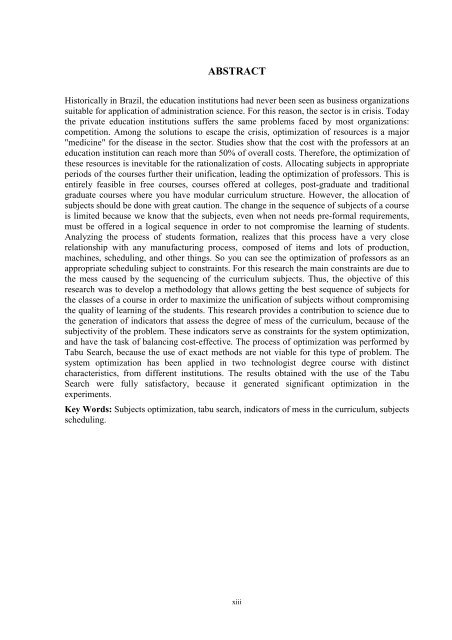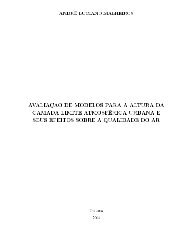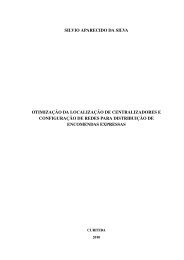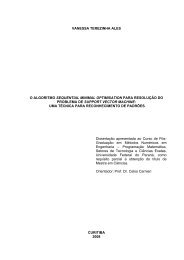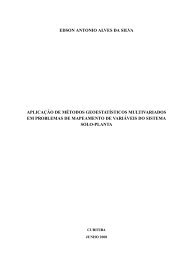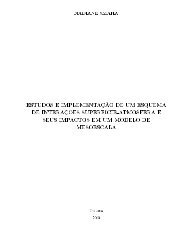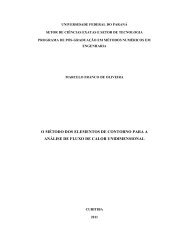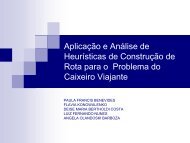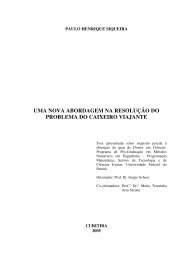15 - programa de pós graduação em métodos numéricos da ufpr ...
15 - programa de pós graduação em métodos numéricos da ufpr ...
15 - programa de pós graduação em métodos numéricos da ufpr ...
You also want an ePaper? Increase the reach of your titles
YUMPU automatically turns print PDFs into web optimized ePapers that Google loves.
ABSTRACT<br />
Historically in Brazil, the education institutions had never been seen as business organizations<br />
suitable for application of administration science. For this reason, the sector is in crisis. To<strong>da</strong>y<br />
the private education institutions suffers the same probl<strong>em</strong>s faced by most organizations:<br />
competition. Among the solutions to escape the crisis, optimization of resources is a major<br />
"medicine" for the disease in the sector. Studies show that the cost with the professors at an<br />
education institution can reach more than 50% of overall costs. Therefore, the optimization of<br />
these resources is inevitable for the rationalization of costs. Allocating subjects in appropriate<br />
periods of the courses further their unification, leading the optimization of professors. This is<br />
entirely feasible in free courses, courses offered at colleges, post-graduate and traditional<br />
graduate courses where you have modular curriculum structure. However, the allocation of<br />
subjects should be done with great caution. The change in the sequence of subjects of a course<br />
is limited because we know that the subjects, even when not needs pre-formal requir<strong>em</strong>ents,<br />
must be offered in a logical sequence in or<strong>de</strong>r to not compromise the learning of stu<strong>de</strong>nts.<br />
Analyzing the process of stu<strong>de</strong>nts formation, realizes that this process have a very close<br />
relationship with any manufacturing process, composed of it<strong>em</strong>s and lots of production,<br />
machines, scheduling, and other things. So you can see the optimization of professors as an<br />
appropriate scheduling subject to constraints. For this research the main constraints are due to<br />
the mess caused by the sequencing of the curriculum subjects. Thus, the objective of this<br />
research was to <strong>de</strong>velop a methodology that allows getting the best sequence of subjects for<br />
the classes of a course in or<strong>de</strong>r to maximize the unification of subjects without compromising<br />
the quality of learning of the stu<strong>de</strong>nts. This research provi<strong>de</strong>s a contribution to science due to<br />
the generation of indicators that assess the <strong>de</strong>gree of mess of the curriculum, because of the<br />
subjectivity of the probl<strong>em</strong>. These indicators serve as constraints for the syst<strong>em</strong> optimization,<br />
and have the task of balancing cost-effective. The process of optimization was performed by<br />
Tabu Search, because the use of exact methods are not viable for this type of probl<strong>em</strong>. The<br />
syst<strong>em</strong> optimization has been applied in two technologist <strong>de</strong>gree course with distinct<br />
characteristics, from different institutions. The results obtained with the use of the Tabu<br />
Search were fully satisfactory, because it generated significant optimization in the<br />
experiments.<br />
Key Words: Subjects optimization, tabu search, indicators of mess in the curriculum, subjects<br />
scheduling.<br />
xiii


